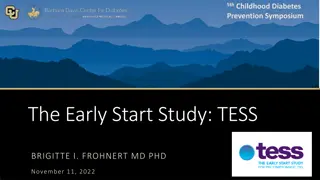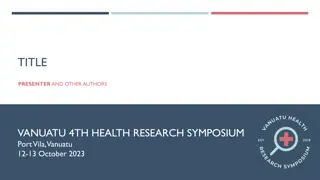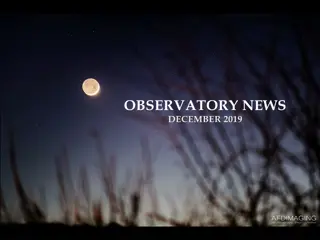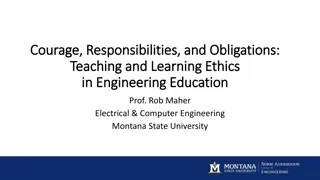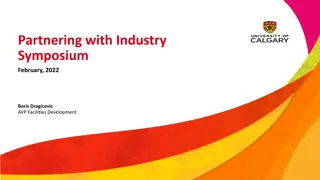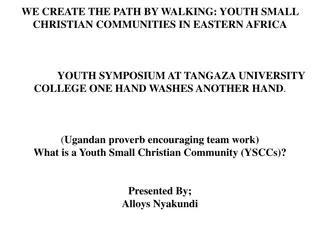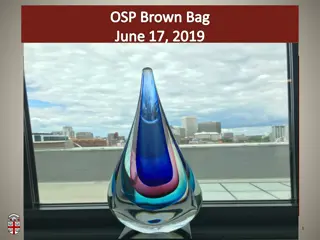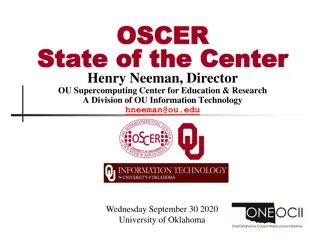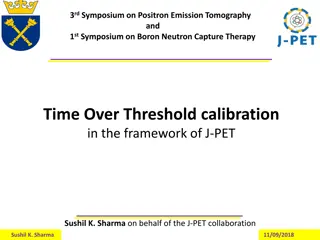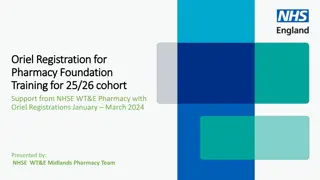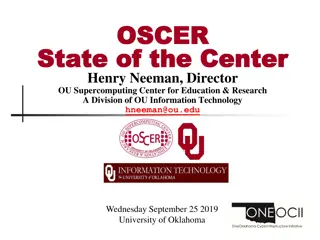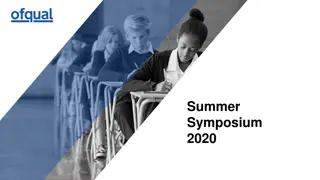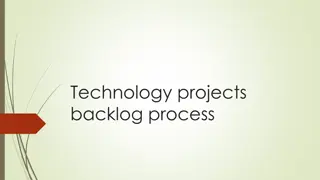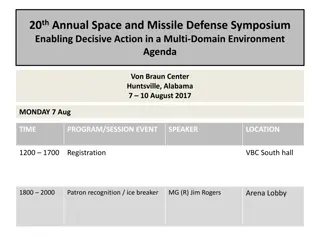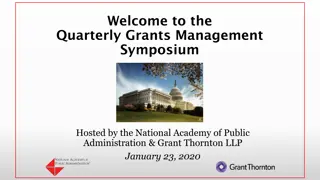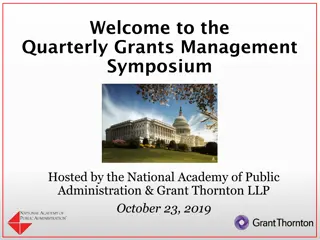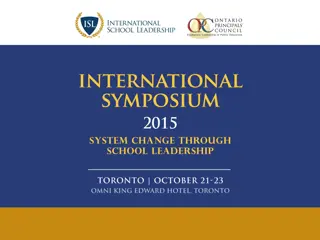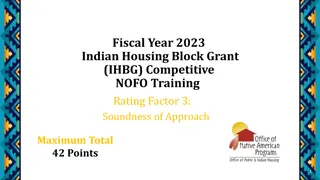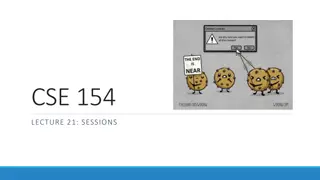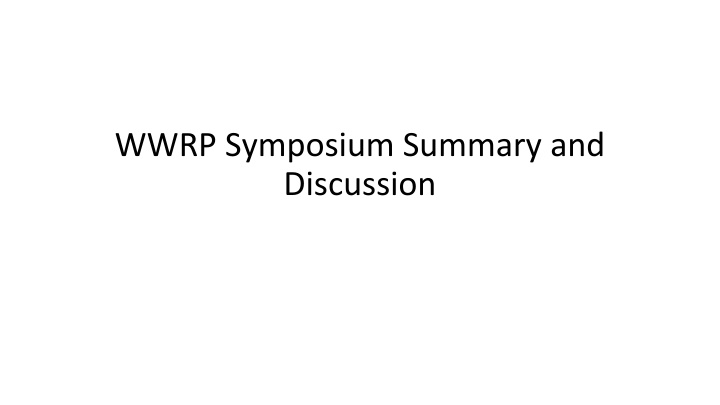
WWRP Symposium: Projects, Sessions, and Challenges
The WWRP Symposium features engaging sessions focusing on projects, with active discussions led by expert speakers. Explore key challenges in S2S prediction, forecast quality, communication, and decision-making across various timescales. Discover insights on improving forecasts, enhancing user value, and the importance of physics-based approaches in climate prediction."
Download Presentation

Please find below an Image/Link to download the presentation.
The content on the website is provided AS IS for your information and personal use only. It may not be sold, licensed, or shared on other websites without obtaining consent from the author. If you encounter any issues during the download, it is possible that the publisher has removed the file from their server.
You are allowed to download the files provided on this website for personal or commercial use, subject to the condition that they are used lawfully. All files are the property of their respective owners.
The content on the website is provided AS IS for your information and personal use only. It may not be sold, licensed, or shared on other websites without obtaining consent from the author.
E N D
Presentation Transcript
WWRP Symposium Summary and Discussion
How the Symposium is going Symposium consists of two 1.5hr sessions (1 for PEOPLE) focusing on each project. Several invited speakers introduced the activities and perspectives related to each project. >30 min active discussions follow the presentations. Wrap up discussions
SAGE (Sub-seasonal Applications for aGriculture and Energy) 1. Joanne Robbins The S2S real time pilot and the value of multi-disciplinary approaches in forecast application development 2. Debbie Hudson S2S research, applications and future challenges An Australian perspective 3. Subinmal Ghosh (IIT Bombay) Farm scale agricultural water management with S2S prediction 4. Alberto Troccoli world energy and meteorol. council Use of muti-model combination and an independence metric in seasonal climate forecast for applications in the energy sector 5. Krishnan Raghavan Understanding the behaviour of the Asian monsoon complex system in a changing climate: A key topic for future of S2S research 6. Andrew Robertson S2S prediction: current status and future challenges Debbie Hudson
SAGE (Sub-seasonal Applications for aGriculture and Energy) Some key challenges for S2S prediction Predictability and interactions across timescales For example, a rare TC (timing and location) cooled large swath of Indian Ocean NW of Australia and caused the IOD switch from negative to positive phase and also influenced on S2S prediction of Australian precipitation Forecasting forecast quality Challenging to communicate (ensemble) verification often misunderstood Forecast quality does not necessarily reflect value Average skill does not represent windows of forecast opportunity Forecast products and decision-making The forecast has little real value, if it doesn t provide information users need; if it isn t issued when users are making their critical decisions; if it is misinterpreted; if it cannot help make a decision Better communicate forecasts (including uncertainties); applying AI/ML to improve forecasts Consistent and seamless information across the timescales, from NWP to climate prediction Focusing on physics is important Debbie Hudson
URBAN(Urban Prediction of Weather Impacts for sustaiNable Development) 1. Marttial Haeffelin Observations needed to aid urban boundary layer research and model development Insights from the on-going PANAME initiative 2. Takemasa Miyoshi Big data assimilation 3. Sue Grimmond Urban weather prediction :: needs for delivering sustainable development 4. Sylvie Leroyer How services can benefit from urban-scale NWP modeling? 5. Isadora Jimenez
URBAN Novel observations aiding urban boundary layer research and model development (M. Haeffelin) At surface-atmosphere interface, Vertical profiles in the boundary layer, In selected contrasted locations (city center vs. urban parks) Sustainable observation systems 30-s-update, 100-m, Big Data Assimilation (T. Miyoshi) fusing AI and DA with HPC Research co-production (I. Jim nez): Urban prediction for WHOM? WHAT is actually needed? To cover WHICH needs? WHO would benefit from it? HOW should data and services be delivered? Science communication: public engagement, increased societal awareness, etc.
IHAPP (Integrated Hydrology And Precipitation Prediction) 1. Vincent Fortin (CANADA) Leveraging improvements in remotely sensed observations of precipitation and soil moisture for water cycle prediction 2. Xubin Zeng : GEWEX SSG Co-Chair Precipitation and Hydrology 3. Chiara Marsigli High-resolution forecast of precipitation and its uncertainty for hydro-meteorological predictions 4. Sally Potter Integrating hydrology and precipitation research with societal needs 5. Osvaldo Moraes Building an Impact-Based Early Warning System (EWS) for Weather, Water, and Climate Hazards
IHAPP Leveraging remote sensing observations of precipitation and soil moisture for water cycle prediction (Vincent Fortin) Water cycle prediction using coupled numerical models and weakly-coupled data assimilation systems provides a flexible framework for taking advantage of remotely sensed observations of precipitation and soil moisture The resulting surface and river prediction system outperforms the driving atmospheric model for near-surface temperature, dew point departure and wind speed prediction Precipitation initiatives and cross-cutting activities at GEWEX (Xubing Zeng) Understanding and predicting extremes Diurnal cycle of convection (GASS) Aerosol-precipitation process (GAP) Precipitation assessment (GDAP) WCRP Global Precipitation EXperiment (GPEX): establishment/expansion of precip dataset; weather-S2S ensemble dataset; support capacity building via workshop etc. Integrated multi-hazard forecasts and warning (Sally Potter) Integration of multi-hazards and disciplines (heavy rain, flooding, landslides, lahars); Integration across WMO; involve vulnerable communities; interagency partnership and data sharing Need to be people-centered, impact-based warming system needs vulnerability and exposure information; social science is critical Disaster risk: hazard point of view (Osvaldo Moraes) understanding: what different types of data need to be collected? forecasting: how to include emerging data in forecasting system? alerting: how to issue warnings in face of uncertainties
Discussion Points 1. What scientific questions does TMR want to address in the context of the TMR- related projects (SAGE, URBAN, IHAPP, ADVANCE)? 2. Desired outcomes (benefit to Members of WMO, Publications, new/improved services to be implemented etc) 3. What activities should we take to achieve the outcomes? 4. Anticipated and/or needed partnerships (GAW, WCRP, INFCOM, SERCOM and/or Member Services (including training/capacity building events in the WMO Regions) TMR CONTRIBUTIONS to each projects: How will we contribute to different projects? What are our priorities by the end of 2023? What specific actionable items should we consider?
SAGE RDP (2024-2028) Sub-seasonal Applications for aGriculture and Energy. Enhancing and securing the necessities of life SDGs, food security, energy and well being.
URBAN RDP (2025-2029) Urban-scale prediction, integrating transportation, energy and hazards to create sustainable cities
IHAPP RDP (2023-2027) Prediction of precipitation and hydrology, mainly focused on the integrated prediction of precipitation and hydrological processes on short time scales (minutes to days), and the advancement of warning strategies associated with multi-hazards and their interdependencies affecting the water cycle.
Panel Discussion on Modelling strategy to improve S2S prediction 1) How to exploit S2S predictability limit to achieve skillful prediction up to 4 weeks and beyond? Which processes parametrizations, coupled data assimilation, initialization, biases...) are most important to deliver improved predictions? (teleconnections, physical 2) Any requirement for new observations to improve the skill or new strategy for incorporating observations? 3) How S2S modelling development activities could be linked to WCRP and other WMO programs?
Panel Discussion will be on Applications and Effective communication of S2S forecast to sectors for socio-economic impacts 1. How S2S probabilistic products are being used and what is the prospect of being used in untapped areas in decision-making for region-specific extreme conditions in various sectors particularly water, agriculture and energy? 1. What are the major research advances that have not been adequately incorporated in the operational practices? And how to treat feedbacks from the industry to science teams? 1. How S2S societal activities could be linked to other WMO programs?
WWRP Projects and WGTRM WWRP Projects From 2024 Working Group or Expert Team HIW Core Project (through 2024) NMR, JWGFVR, SERA, PDEF, SERA, HAP NMR, JWGFVR, PDEF, DAOS, SERA Paris RDP (through 2024) Aviation RDP-2 (through 2025) NMR, JWGFVR, PDEF SERA JWGFVR, PDEF, SERA, TMR, WxMOD, HAP TC-PFP (through 2025) JWGFVR, PDEF, DAOS, SERA PCAP (2024-2028) JWGFVR, PDEF, DAOS, SERA, TMR, HAP SAGE (2024-2028) NMR, JWGFVR, SERA, PDEF, DAOS, TMR UPWIND (2025-2029) IHAPP (2023-2027) NMR, JWGFVR, SERA, PDEF, DAOS, TMR, WxMOD, HAP ADVANCE (FDP 2023- 2027) NMR, JWGFVR, SERA, DAOS, TMR, HAP All WGs PEOPLE (2024-2027)
Synthesis Questions WHY has the research under this topic (inside and outside of WWRP) had limited real benefits and applications? (Think about issues that are inside our control.) GOAL: What are the science gaps in the development of forecasts (physical science) and decision-making (social science) that limit our ability to provide useful solutions under this topic? What are we trying to achieve and why? Are there near-term applications of the science that are relatively untapped? What does the situation look like if the problems are solved? SOLUTIONS AND PARTNERSHIPS (Pathways to Impact): Referencing the WWRP draft Implementation Plan, what science do we need to explore (data, techniques, expertise, knowledge, policies, etc.)? What types of people need to come together to solve these issues (E.g., local communities and representatives, regional communities, economic sectors, WWRP working groups, WMO departments and divisions)? TMR CONTRIBUTION: How will we contribute to different projects? What are our priorities by the end of 2023? What specific actionable items should we consider?

